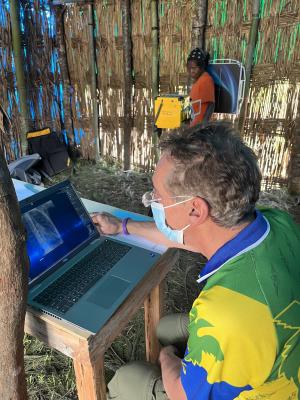
Dr. Robert Liddell
April 1, 2024 — MinXray, a leading manufacturer of imaging systems for medical and veterinary use, recently sent its Impact Wireless X-ray system with a group of researchers and medical personnel to the YUS Conservation Area in Papua New Guinea. During this time, they spent 10 days in a local village to provide healthcare services and health education sessions.
This trip was sponsored by the Tree Kangaroo Conservation Program, a partnership between Seattle’s Woodland Park Zoo and the local governments and remote populations in Papua New Guinea. This initiative utilizes a One Health practice of holistic conservation by providing these important resources to help local people who have previously relied on the endangered Matschie’s tree kangaroos for protein and clothing.
Rob Liddell, MD, is a diagnostic radiologist who used MinXray’s Impact Wireless system to take radiographic images of patients in the village and screen for common diseases in the region, such as tuberculosis and emphysema. He also used the system to diagnose cancers, infections and various musculoskeletal injuries. For most other imaging equipment, this task would have been impossible due to the lack of electricity in the village. However, the Impact Wireless system runs on batteries that could be recharged using the team’s solar panels.
“The Impact Wireless system performed perfectly, even with the high elevation and humidity,” said Dr. Liddell. “Over 80 percent of Papua New Guineans live in rural populations, meaning that normally, diagnostic services like X-ray imaging require a multi-day walk. With this technology, we were able to bring this resource and important information about their health to them.”
Dr. Liddell was joined by several other specialists including a Papua New Guinean nutritionist and health education trainers as well as a physical therapist, emergency room doctor, OB-GYN and Dr. Liddell’s wife, Marti Liddell, MD, an internist. Over 400 people came to attend the healthcare education seminars throughout the time that the team was in the village, and the healthcare professionals were able to see approximately 200 as patients.
The 10 days before traveling to the village were spent in a high-elevation research facility with the goal of working towards establishing a baseline for the Matschie’s tree kangaroo species, which is endangered and endemic to Papua New Guinea. To achieve this, eight tree kangaroos were humanely captured and studied before being microchipped, GPS-collared and returned to the same spot from which they were captured. The examination included measuring the size and shape of the tree kangaroos’ bodies, inspecting pouches on females, analyzing acquired blood samples and taking radiographic images of the animals with the Impact Wireless system. In addition, Dr. Liddell was able to use the system to compare conditions found in wild tree kangaroos to those in human care.
This is the fifth trip to the region that the medical group has taken since the conservation program’s founding 25 years ago and second trip that also included a visit to the tree kangaroo research base camp. Going forward, the group hopes to continue providing health services to local people and researching the Matschie’s tree kangaroos with trips every other year.
For more information: www.minxray.com


 December 10, 2025
December 10, 2025 









